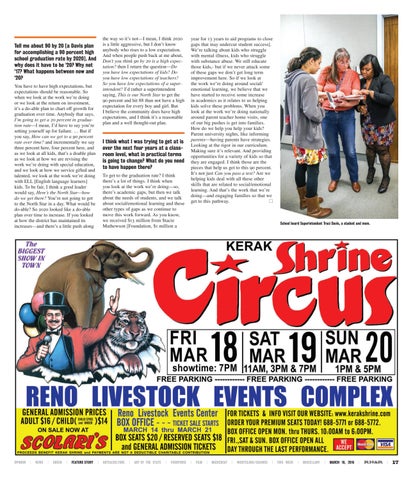the way so it’s not—I mean, I think 2020 is a little aggressive, but I don’t know anybody who rises to a low expectation. And when people push back at me about, Don’t you think 90 by 20 is a high expectation? then I return the question—Do you have low expectations of kids? Do you have low expectations of teachers? So you have low expectations of a superintendent? I’d rather a superintendent saying, This is our North Star to get the 90 percent and hit 88 than not have a high expectation for every boy and girl. But I believe the community does have high expectations, and I think it’s a reasonable plan and a well thought-out plan.
Tell me about 90 by 20 [a Davis plan for accomplishing a 90 percent high school graduation rate by 2020]. And why does it have to be ’20? Why not ’17? What happens between now and ’20? You have to have high expectations, but expectations should be reasonable. So when we look at the work we’re doing or we look at the return on investment, it’s a do-able plan to chart off growth for graduation over time. Anybody that says, I’m going to get a 20 percent in graduation rate—I mean, I’d have to say you’re setting yourself up for failure. … But if you say, How can we get to a 90 percent rate over time? and incrementally we say three percent here, four percent here, and as we look at all kids, that’s a doable plan as we look at how we are revising the work we’re doing with special education, and we look at how we service gifted and talented, we look at the work we’re doing with ELL [English language learners] kids. To be fair, I think a good leader would say, Here’s the North Star—how do we get there? You’re not going to get to the North Star in a day. What would be do-able? So 2020 looked like a do-able plan over time to increase. If you looked at how the district has maintained its increases—and there’s a little push along
OPINION
|
NEWS
|
GREEN
|
FEATURE STORY
I think what I was trying to get at is over the next four years at a classroom level, what in practical terms is going to change? What do you need to have happen there? To get to the graduation rate? I think there’s a lot of things. I think when you look at the work we’re doing—so, there’s academic gaps, but then we talk about the needs of students, and we talk about social/emotional learning and these other types of gaps as we continue to move this work forward. As you know, we received $13 million from Stacie Mathewson [Foundation, $1 million a
|
ARTS&CULTURE
|
ART OF THE STATE
|
FOODFINDS
year for 13 years to aid programs to close gaps that may undercut student success]. We’re talking about kids who struggle with mental illness, kids who struggle with substance abuse. We still educate those kids,- but if we never attack some of these gaps we don’t get long term improvement here. So if we look at the work we’re doing around social/ emotional learning, we believe that we have started to receive some increase in academics as it relates to us helping kids solve these problems. When you look at the work we’re doing nationally around parent teacher home visits, one of our big pushes is get into families. How do we help you help your kids? Parent university nights, like informing parents—having parents have strategies. Looking at the rigor in our curriculum. Making sure it’s relevant. And providing opportunities for a variety of kids so that they are engaged. I think those are the pieces that help us get to this 90 percent. It’s not just Can you pass a test? Are we helping kids deal with all these other skills that are related to social/emotional learning. And that’s the work that we’re doing—and engaging families so that we get to this pathway. Ω
School board Superintendent Traci Davis, a student and mom.
|
FILM
|
MUSICBEAT
|
NIGHTCLUBS/CASINOS
|
THIS WEEK
|
MISCELLANY
|
MARCH 10, 2016
|
RN&R
|
17











